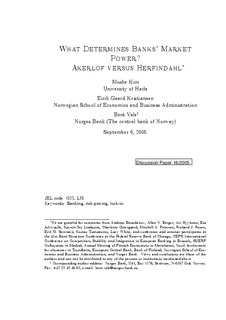| dc.contributor.author | Kim, Moshe | |
| dc.contributor.author | Kristiansen, Eirik Gaard | |
| dc.contributor.author | Vale, Bent | |
| dc.date.accessioned | 2006-07-10T10:21:29Z | |
| dc.date.available | 2006-07-10T10:21:29Z | |
| dc.date.issued | 2005-09 | |
| dc.identifier.issn | 0804-6824 | |
| dc.identifier.uri | http://hdl.handle.net/11250/162702 | |
| dc.description.abstract | We introduce a model analyzing how asymmetric information problems in
a bank-loan market may evolve over the age of a borrowing firm. The model
predicts a life-cycle pattern for banks’ interest rate markup. Young firms pay
a low or negative markup, thereafter the markup increases until it falls for old
firms. Furthermore, the pattern of the life-cycle depends on the informational
advantage of the inside bank and when more dispersed borrower information
yields fiercer bank competition. By applying a new measure of the informational
advantage of inside banks and a large sample of small Norwegian firms,
we find empirical support for the predicted markup pattern. We disentangle
effects of asymmetric information (Akerlof effect) from effects of a concentrated
bank market (Herfindahl effect). Our results indicate that the interest
rate markups are not influenced by bank market concentration. | en |
| dc.format.extent | 335280 bytes | |
| dc.format.mimetype | application/pdf | |
| dc.language.iso | eng | en |
| dc.publisher | Norwegian School of Economics and Business Administration. Department of Economics | en |
| dc.relation.ispartofseries | Discussion paper | en |
| dc.relation.ispartofseries | 2005:16 | en |
| dc.subject | banking | en |
| dc.subject | risk-pricing | en |
| dc.subject | lock-in | en |
| dc.title | What determines banks’ market power? : Akerlof versus Herfindahl | en |
| dc.type | Working paper | en |
